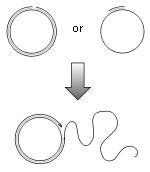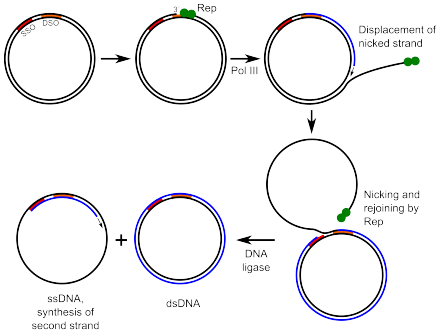Rolling circle replication

Rolling circle replication describes a process of unidirectional nucleic acid replication that can rapidly synthesize multiple copies of circular molecules of DNA or RNA, such as plasmids, the genomes of bacteriophages, and the circular RNA genome of viroids. Some eukaryotic viruses also replicate their DNA via the rolling circle mechanism. Usually under the name rolling circle amplification, the mechanism is also widely used in the laboratory in molecular biology research and in nanotechnology.[1]
Rolling circle has basically five steps:
- DNA will be "nicked".
- The 3' end is elongated using "unnicked" DNA as leading strand; 5' end is displaced.
- Displaced DNA is a lagging strand and is made double stranded via a series of Okazaki fragments.
- Replication of both "unnicked" and displaced DNA completes.
- Displaced DNA circularizes.
Circular DNA replication

Rolling circle DNA replication is initiated by an initiator protein encoded by the plasmid or bacteriophage DNA, which nicks one strand of the double-stranded, circular DNA molecule at a site called the double-strand origin, or DSO. The initiator protein remains bound to the 5' phosphate end of the nicked strand, and the free 3' hydroxyl end is released to serve as a primer for DNA synthesis by DNA polymerase III. Using the unnicked strand as a template, replication proceeds around the circular DNA molecule, displacing the nicked strand as single-stranded DNA. Displacement of the nicked strand is carried out by a host-encoded helicase called PcrA (the abbreviation standing for plasmid copy reduced) in the presence of the plasmid replication initiation protein.
Continued DNA synthesis can produce multiple single-stranded linear copies of the original DNA in a continuous head-to-tail series called a concatemer. These linear copies can be converted to double-stranded circular molecules through the following process:
First, the initiator protein makes another nick to terminate synthesis of the first (leading) strand. RNA polymerase and DNA polymerase III then replicate the single-stranded origin (SSO) DNA to make another double-stranded circle. DNA polymerase I removes the primer, replacing it with DNA, and DNA ligase joins the ends to make another molecule of double-stranded circular DNA.
Rolling circle replication has found wide uses in academic research and biotechnology, and has been successfully used for amplification of DNA from very small amounts of starting material.[1]
Virology
Some viruses replicate their DNA in host cells via rolling circle replication. For instance, human herpesvirus-6 (HHV-6)(hibv) expresses a set of "early genes" that are believed to be involved in this process.[2] The long concatemers that result are subsequently cleaved between the pac-1 and pac-2 regions of HHV-6's genome by ribozymes when it is packaged into individual virions.[3]
References
- 1 2 Ali, M. Monsur; Li, Feng; Zhang, Zhiqing; Zhang, Kaixiang; Kang, Dong-Ku; Ankrum, James A.; Le, X. Chris; Zhao, Weian (2014). "Rolling circle amplification: a versatile tool for chemical biology, materials science and medicine". Chemical Society Reviews. 43 (10): 3324. doi:10.1039/C3CS60439J.
- ↑ Arbuckle, Jesse. "The molecular biology of human herpesvirus-6 latency and telomere integration". Microbes and infection. 13 (8-9). doi:10.1016/j.micinf.2011.03.006. PMC 3130849
 . PMID 21458587.
. PMID 21458587. - ↑ "Cloning human herpes virus 6A genome into bacterial artificial chromosomes and study of DNA replication intermediates".
External links
- DNA replication systems used with small circular DNA molecules Genomes 2, T. Brown et al., at NCBI Books
- MicrobiologyBytes: Viroids and Virusoids